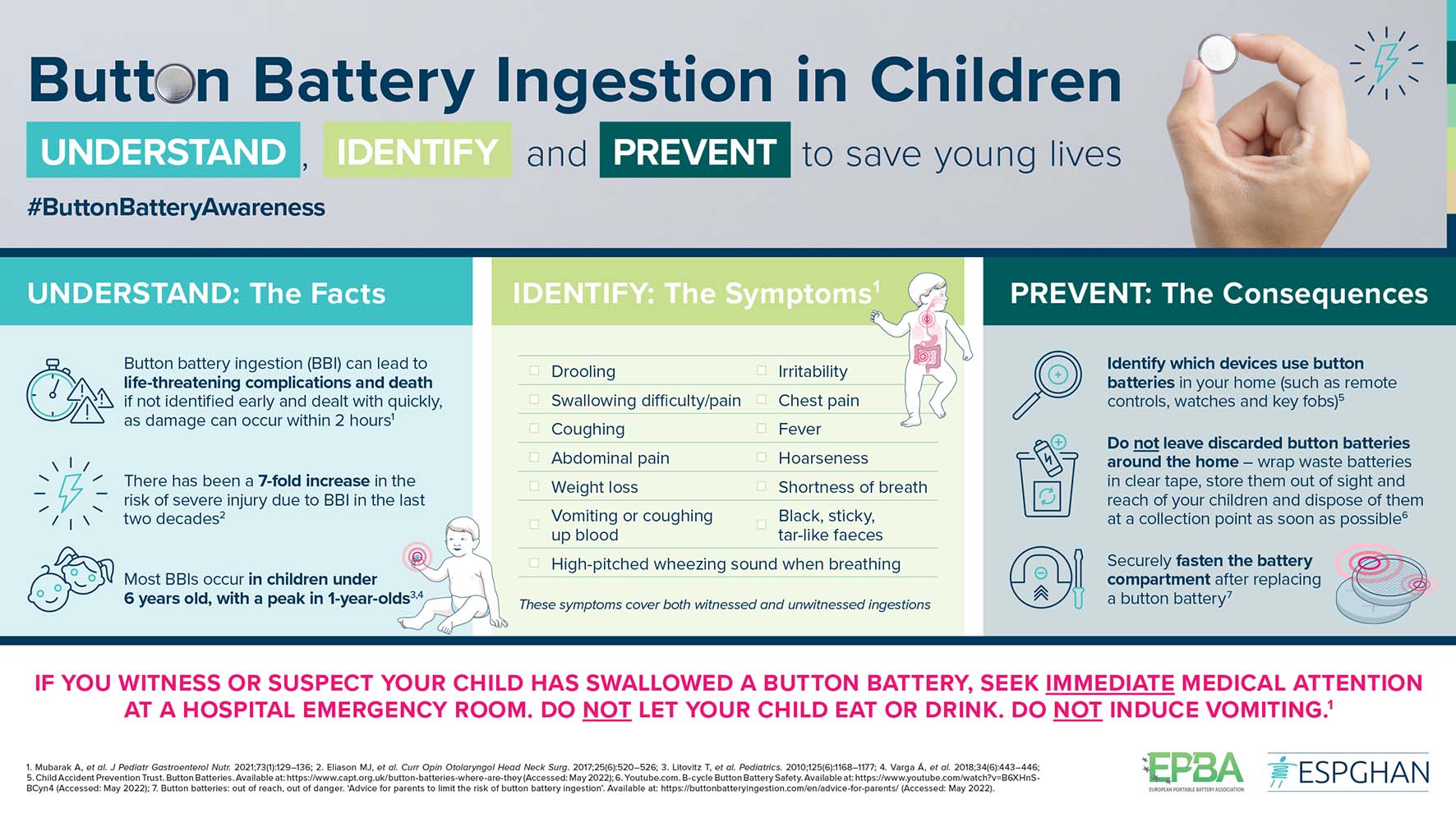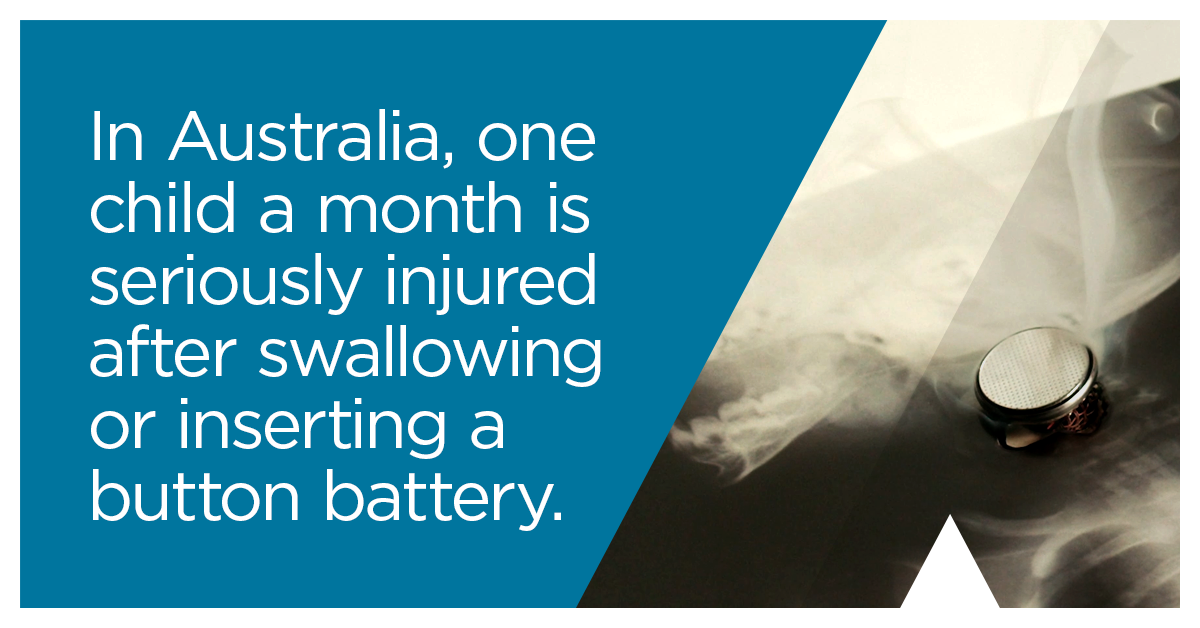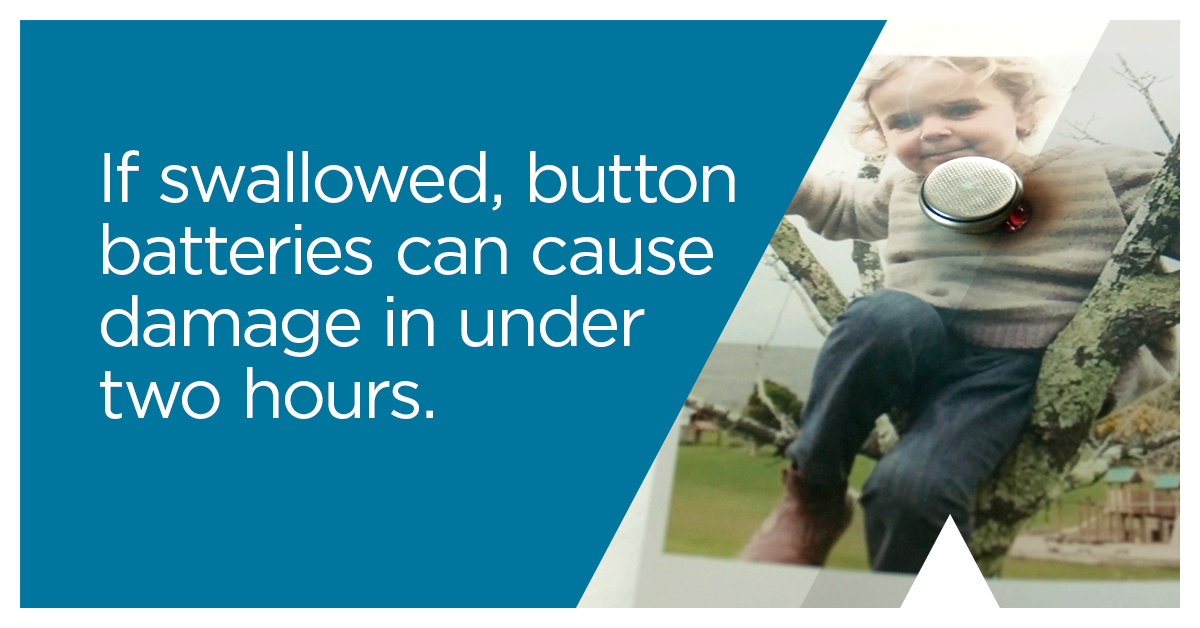Button Batteries dangers
THE DANGERS OF BUTTON BATTERIES
International Button Battery Awareness Day was on Sunday 12th June 2022. This graphic aims to help parents understand, identify and prevent button battery ingestion in their child, and how to act if it occurs.
ESPGHAN produced this graphic in collaboration with the European Portable Battery Association (EPBA)

New mandatory standards for button batteries from 22 June 2022
The Australian Government has introduced four new mandatory standards for button batteries and products containing button batteries. The reason for the new standards is to reduce the risk of death and injury associated with button batteries.
What do the new standards mean?
· Secure battery compartments on products that contain button batteries.
· Compliance testing to demonstrate the batteries are secure.
· Child-resistant packaging.
· Warnings and information on packaging.
All businesses that supply button batteries or products containing button batteries in Australia must comply with the new standards by 22 June 2022.
Button Battery Safety – Supplier guide and fact sheet for mandatory standards
In December 2020 the Australian Government made mandatory safety and information standards for button batteries and consumer goods containing them. (See below)
The ACCC has developed A Guide for Business on the Application of Mandatory Standards (click here). The purpose of this guide is to assist suppliers in understanding the requirements for secure battery compartments, child resistant packaging, and warnings and information.
The ACCC has also developed a Fact Sheet (click here) which summarises the requirements of the new standards for the benefit of suppliers.
Both documents are available on the Product Safety Australia website by clicking on the above links.
Button Batteries new mandatory standard announced
PRODUCT SAFETY AUSTRALIA (ACCC) welcomes safety and information standards for button batteries
The ACCC has welcomed the Federal Government’s decision to improve the safety of button batteries by introducing new safety regulations.
Click here for the full announcement by the ACCC
Under the new mandatory safety and information standards manufacturers must:
- Manufacture their products with secure battery compartments to prevent children from gaining access to the batteries.
- Undertake compliance testing to demonstrate batteries are secure
- Supply higher risk batteries in child-resistant packaging
- Place additional warnings and emergency advice on packaging and instructions.
Button batteries can be incredibly dangerous to young children, especially for children five years of age and under. If swallowed, a button battery can get stuck in a child’s throat and cause a chemical reaction that burns through tissue, causing death or serious injury. Insertion of a button battery into body orifices such as ears and noses can also lead to significant injuries.
In Australia, one child a month is seriously injured after swallowing or inserting a button battery, with some of them sustaining serious, lifelong injuries. In Australia and globally, there is a growing record of injuries and deaths from button batteries.
“Australia has become the first country in the world to have a button battery safety standard that applies across all consumer product categories,” ACCC Deputy Chair Delia Rickard said.
“The standards will enable the ACCC to take strong action to ensure that businesses sell safe products. We encourage all businesses to transition to the new standards as quickly as possible.”
All businesses that supply button batteries or products containing button batteries in Australia must comply with the standards. Businesses will have 18 months to comply with the new standards.
The ACCC will make guidance material about the standards available to make it easy for all businesses to understand their obligations and for consumers to know what they can expect when buying button battery products.
More information about the button battery related mandatory standards is available from the Product Safety Australia Website.
Background
The ACCC has worked with industry and state and territory Australian Consumer Law (ACL) regulators to improve the safety of button batteries and products that contain them for many years.
Regulators assessed products containing button batteries, and promoted information to assist suppliers to source safer products. The ACCC has engaged with suppliers for recalls of unsafe products that contain button batteries.
Regulators also undertook consumer education activities to raise awareness of the hazard of button batteries to consumers and business. The ACCC recently launched the ‘Tiny batteries – big danger’ safety campaign which included a short video describing the dangers of button batteries and explaining the importance of parents and carers keeping them away from children.
The issue of button battery safety is complex because mandatory safety and information standards for consumer goods with button batteries apply to a vast range of products, most of which are manufactured overseas and imported into Australia.
Button batteries are used in thousands of different products across many categories of consumer products. For some categories of consumer products, there are voluntary industry standards that include button battery safety requirements. The new mandatory standards have taken into account that some suppliers comply with voluntary industry standards that include acceptable button battery safety requirements. The regulatory burden of the new standards will be minimal for suppliers that currently adhere to these voluntary industry standards.
After broad consultation with national and international stakeholders in industry and medical professionals, the ACCC recommended that the Government adopt mandatory safety and information standards for button battery safety that apply to all consumer products sold in Australia.
From the time a child swallows a button battery they are ‘walking dead’

Following the death of a 3rd child in Australia due to an ingested button battery, Kidsafe are issuing an urgent reminder to everyone to be Button Battery Aware.
As the number of babies, toddlers and older children hospitalised after swallowing button batteries continues to rise, Kidsafe has issued a fresh warning that button batteries can inflict catastrophic injury and kill.
In Australia, more than one child a month sustains a time critical or severe injury related to swallowing or inserting (into nose or ears) a button battery, with children under five years of age proving to be at greatest risk.
These little batteries present a serious danger to children and can kill if not found in time. If swallowed, a fully charged large (3V) button battery can erode through the oesophagus in as little as two hours. Even when the battery has been removed, the chemical burn can continue to erode through tissue.
Most severe injuries and deaths are associated with ‘occult ingestions’ where a child swallows a button battery but fails to report this to parents/carers. Though this is more common with preverbal and non-verbal children, it also occurs in older children who fear there may be repercussions or may not think to mention it.
Dr Ruth Barker Emergency Paediatrician and Kidsafe Qld President says “These children are ‘walking dead’ from the moment they swallow the battery, because they do not look unwell. Although the parents notice something is not quite right, no-one can put their finger on it. When the diagnosis is revealed, it can be too late. The aftermath of realizing what everyone had been missing is devastating.”
Importantly, even a battery that no longer has enough charge to power your product, may still have the capacity to kill. A large 3V lithium battery has a shelf life of 10 years.
For 40 years companies have been deploying these ‘landmines’ into our homes with no warnings, unsecured battery compartments and no information on what to do if a child swallows or inserts one.
Whilst the mainstream toy industry has been diligent about this issue; making battery compartments child resistant and their products durable and impact resistant; families are increasingly exposed to a deluge of cheap, low quality products across a staggering range of suppliers. The onus is on industry to come up with better and safer solutions to this worldwide killer.
In Australia, Kidsafe is looking forward to world-first legislation, with the ACCC looking at a mandatory safety standard for all products containing button batteries.
Reduce the number of products in your environment that are powered by button batteries. Although injury can still occur with cylindrical batteries this is much less common. Can you source products with enclosed batteries (USB rechargeable) or powered by alternative batteries or power sources?
Secure button batteries and the products they power. Only purchase button batteries in child resistant packaging. Products need to be durable and the battery compartments child resistant. If dropped or the compartment prised open will the battery be released?
Know which products in your home have button batteries. Regularly check that the battery is still secured in the child-resistant compartment. Where you can, keep them out of reach of small children (though beware climbers!)
Dispose of spent and unused batteries immediately and safely – ‘flat’ batteries are still dangerous. Tape them both sides with sticky tape as they come out of the product. This reduces fire risk if you are storing them for recycling and makes them a tricky mouthful to swallow. Kids can be like vultures waiting to pounce!
Recognise the signs and symptoms of occult ingestion; gagging, drooling, unable to eat properly, noisy breathing, chest pain (grunting) vomiting or passing black or red blood.
Respond immediately if you suspect someone has swallowed or inserted a button battery. Not every health facility has the capacity to assess or manage a button battery injury, so call the Poisons Information Centre first on 13 11 26 (24/7) for fast expert advice.
Warn others about the dangers of button batteries.
This video describes the risks and type of injury. Click here or on the image below to watch the video.








